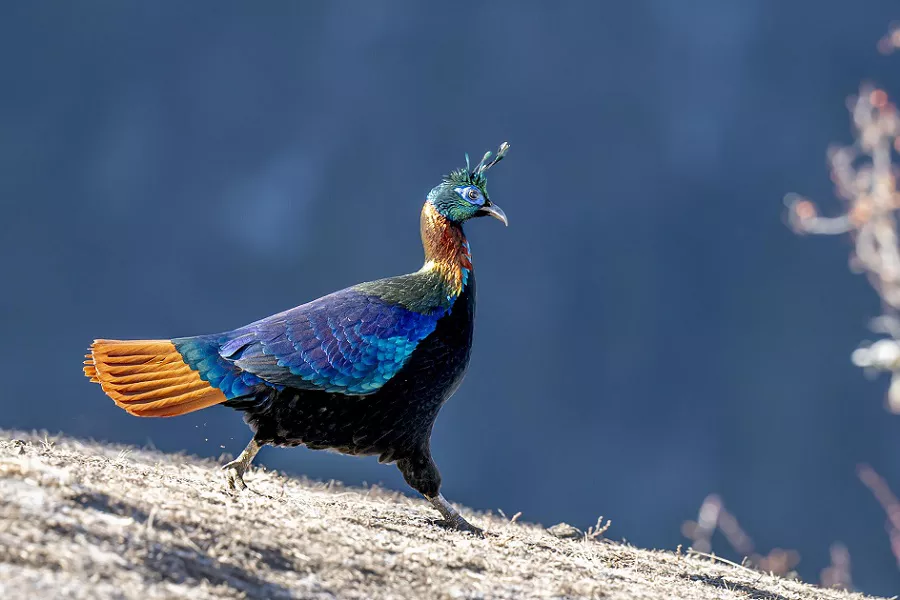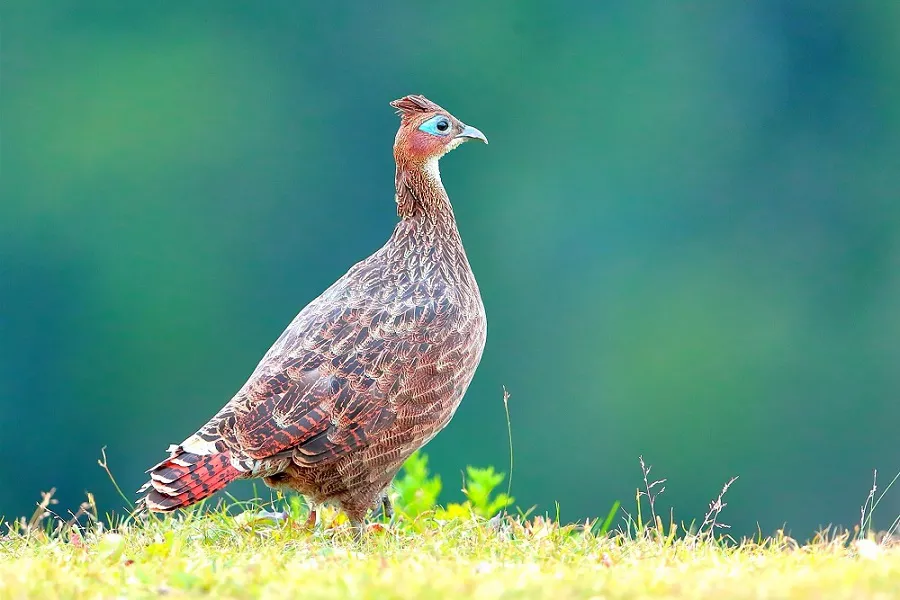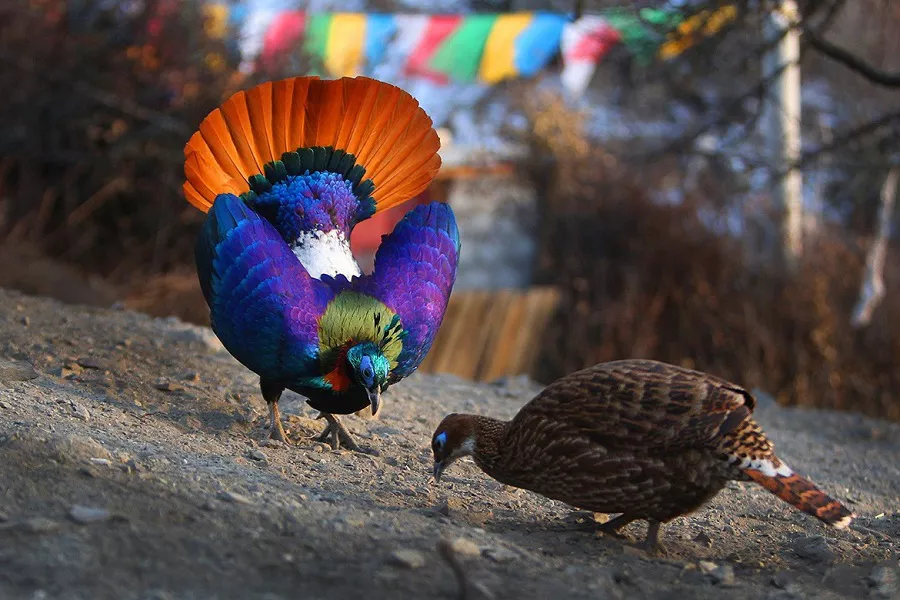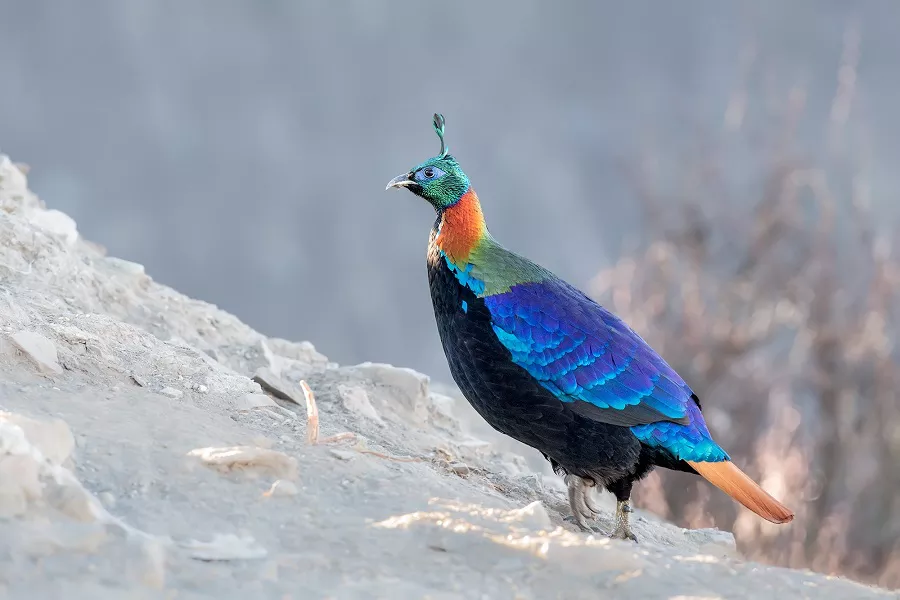Nepal, a land of natural wonders nestled in the lap of the Himalayas, boasts a rich biodiversity that includes some of the most magnificent avian species. Among these, the Himalayan Monal (Lophophorus impejanus) stands out as a symbol of pride and magnificence, holding the esteemed title of Nepal’s national bird. Known locally as “danphe” or “danfe,” this splendid creature encapsulates the essence of Nepal’s natural heritage and cultural identity.
Physical Characteristics of the Himalayan Monal
The Himalayan Monal (Lophophorus impejanus), a member of the pheasant family, is a strikingly beautiful bird renowned for its vibrant plumage and regal demeanor. Himalayan Monal is native to the Himalayan regions of Nepal, India, Bhutan, Pakistan, and China. Here are some of its physical characteristics:
Vibrant Plumage: The most striking feature of the Himalayan Monal is its iridescent plumage. Males are particularly colorful, with a metallic green head, coppery feathers on the back and upper breast, blue wings, and a long, iridescent green tail with distinctive markings. Females are less colorful but still possess a beautiful combination of browns, grays, and blacks.
Size: Himalayan Monals are relatively large birds, with males typically measuring around 70-74 centimeters (27-29 inches) in length, including their long tail, and females slightly smaller.
Distinctive Crest: Both males and females have a distinctive crest on their heads, which they can raise and lower. In males, the crest is particularly prominent and is often used in courtship displays.
Facial Features: Their faces are adorned with a combination of colors, including blue, green, and red around the eyes and on the throat.
Bill and Legs: They have relatively short bills compared to some other bird species, and their legs are sturdy and well-adapted for walking and perching in mountainous terrain.
Sexual Dimorphism: There is significant sexual dimorphism in Himalayan Monals, with males being much more colorful and larger than females. This difference in appearance is a result of sexual selection, as males use their vibrant plumage in courtship displays to attract mates.

Male Himalayan monal
Habitat and Range
This magnificent bird is found across the Himalayas, spanning regions from Afghanistan and Pakistan to Nepal, southern Tibet, and Bhutan. Within its range, it inhabits elevations ranging from 2,100 to 4,500 meters (6,900–14,800 feet), favoring alpine and sub-alpine zones, rhododendron forests, grassy slopes, and rocky terrains. Specific regions in Pakistan and India, such as the Himalayan foothills, serve as prime habitats where the Himalayan Monal is commonly sighted.
See Also: Malaysia’s national bird
Diet and Behavior
The Himalayan Monal’s diet is diverse, consisting of tubers, roots, seeds, berries, mosses, insects, and grubs. Its foraging behavior involves digging with robust bills, allowing it to access buried food items with ease. Beyond sustenance, the bird plays a crucial role in ecosystem dynamics, contributing to seed dispersal, insect control, and maintaining ecological balance, making it an integral part of the Himalayan ecosystem.
During the breeding season, which typically occurs from April to June, males engage in elaborate courtship displays to attract mates. These displays involve fluffing up their plumage, erecting their crest feathers, and emitting melodious calls to establish dominance and impress potential partners.
Once mating occurs, females construct shallow ground nests concealed among dense vegetation, where they lay a clutch of eggs. Incubation lasts for approximately three weeks, after which the precocial chicks hatch, equipped with downy feathers and the ability to forage independently shortly after birth.

Female Himalayan Monal
Conservation Status
Globally, the Himalayan Monal is classified as “Least Concern” on the IUCN Red List, indicative of its relatively stable population. However, in Nepal, it is categorized as “Near Threatened,” highlighting the need for focused conservation efforts to safeguard its future. The degradation of its habitat due to human activities, including deforestation and habitat fragmentation, poses significant threats to its long-term survival, underscoring the urgency of conservation initiatives aimed at protecting this iconic species.
See Also: Grenada’s National Bird
The Symbolic Significance of the Himalayan Monal
The designation of the Himalayan Monal as Nepal’s national bird is steeped in symbolism and cultural significance. Known locally as the “Danphe,” this colorful pheasant holds a revered place in Nepali culture and folklore. Its vibrant plumage, comprising iridescent shades of blue, green, red, and gold, symbolizes the vibrant diversity and natural beauty of Nepal’s landscapes.
In Nepali mythology, the Himalayan Monal is often depicted as a messenger of the gods, revered for its grace, beauty, and connection to the divine. Its presence in traditional folk songs, dances, and rituals further underscores its cultural importance, serving as a symbol of national pride and identity.

Himalayan Monal Courting
Some Interesting Facts About Himalayan Monal
The Himalayan Monal, also known simply as the Monal or Impeyan Monal, is a stunningly beautiful bird found in the Himalayan region. Here are some interesting facts about them:
Name: The scientific name of the Himalayan monal commemorates Lady Mary Impey, the wife of the British chief justice of Bengal, Sir Elijah Impey.
Breeding: During the breeding season, which typically occurs between April and August, male Monals engage in elaborate courtship displays to attract females. These displays involve spreading their wings and tail feathers, and hopping around while emitting loud calls.
Nesting: Himalayan Monals typically nest in concealed spots on the ground, often under bushes or in tall grass. The female lays a clutch of 5 to 8 eggs, which she incubates for about three weeks.
Diet: These birds are omnivorous, feeding on a variety of plant matter such as seeds, berries, and buds, as well as insects and small invertebrates.
Conclusion
In conclusion, the Himalayan Monal epitomizes the natural beauty and cultural heritage of Nepal, serving as a living testament to the country’s rich biodiversity and deep-rooted traditions. As Nepal’s national bird, it embodies the spirit of resilience and vitality that defines the nation, inspiring awe and admiration in all who encounter it. However, with its conservation status in Nepal classified as “Near Threatened,” concerted efforts are needed to ensure its continued survival for future generations to marvel at and cherish. By preserving its habitat and addressing the underlying threats to its existence, we can honor the legacy of this iconic bird and safeguard the natural treasures of the Himalayas for generations to come.
FAQs
1. What is Nepal’s National Flower?
Nepal’s National Flower is the Rhododendron (Rhododendron arboreum), locally known as “Laligurans.” It is a beautiful, vibrant flower that grows abundantly in the Himalayan region.
2. What is Nepal’s National Fruit?
A: The national fruit of Nepal is the Daphne bholua, also known as Lapsi or Nepalese Hog Plum. It’s a sour fruit commonly used in making pickles, chutneys, and sauces in Nepali cuisine.
3. What is Nepal’s National Food?
While Nepal doesn’t have an official national dish, one of the most iconic and beloved dishes is Dal Bhat, which consists of lentil soup (dal) served with steamed rice (bhat). It’s a staple in Nepalese cuisine and is often accompanied by various side dishes such as vegetables, pickles, and meat curries.
4. What is Nepal’s National Tree?
A: The national tree of Nepal is the Rhododendron, which also serves as the national flower. With its lush blooms and wide distribution across Nepal’s mountainous terrain, it’s an emblem of the country’s natural wealth and biodiversity.
5. What is Nepal’s National Flag?
Nepal’s National Flag is a unique double pennant design with a crimson red background and a blue border. It features two overlapping triangles – the upper triangle containing a white stylized moon and the lower triangle containing a white twelve-pointed sun. It’s one of the few non-quadrilateral national flags in the world.
6. What is Nepal’s National Animal?
A: The national animal of Nepal is the Cow (Bos indicus), which holds cultural and religious significance in Nepali society. Cows are revered as sacred animals and are integral to the agrarian way of life in Nepal.


 Facebook
Facebook  Instagram
Instagram  Youtube
Youtube 